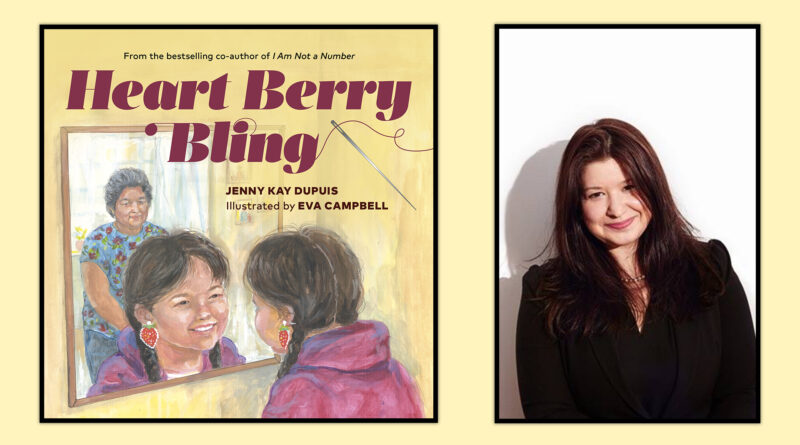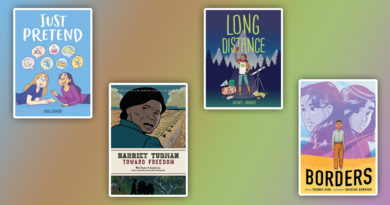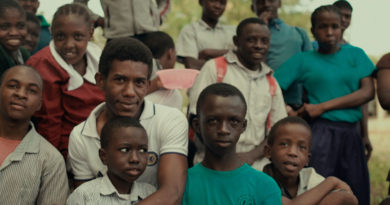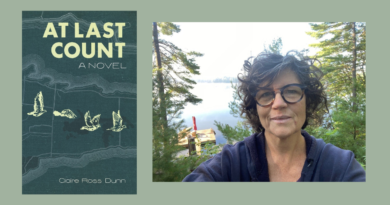Jenny Kay Dupuis’ “Heart Berry Bling” conjures the beauty of family and the injustice of the Indian Act

Jenny Kay Dupuis is an Anishinaabe award-winning, best-selling author, educator, artist, and public speaker from Nipissing First Nation in Ontario, Canada. Her new picture book, Heart Berry Bling, illustrated by Eva Campbell (HighWater Press, 2023) captures the lived experiences of many First Nations women and children, including Dupuis’ own grandmother and father, and herself.
After finishing her doctoral studies in educational leadership, Dupuis began to think about ways to share stories creatively and accurately portray Indigenous (Anishinaabe-specific) community cultures in children’s literature. “My motivation came from within,” she shares. And through writing her first book I Am Not a Number, she “quickly came to see how storywork can help to spark meaningful conversations and foster understandings between groups of Indigenous and non-Indigenous peoples.”
Heart Berry Bling brings together Dupuis’ real-life experiences and those of others in a story that depicts the impacts of Canada’s Indian Act: “I’ve wanted to write about the impact of the Indian Act on thousands of First Nations women and children in Canada for a very long time,” Dupuis explains. “The Indian Act discriminated against my family and me in real life, and until the rules were changed over various periods of time, we were not eligible for First Nations status.”
She recognized that few children (and not many more adults) knew about this revocation of rights, so she wanted to make the government’s discriminatory practice comprehensible for young readers. But she struggled initially with how to turn this concept into a story for young children. It can be challenging to talk about laws and the Indian Act with young readers, but doing so is essential to fostering an understanding of Indigenous peoples and their experiences.
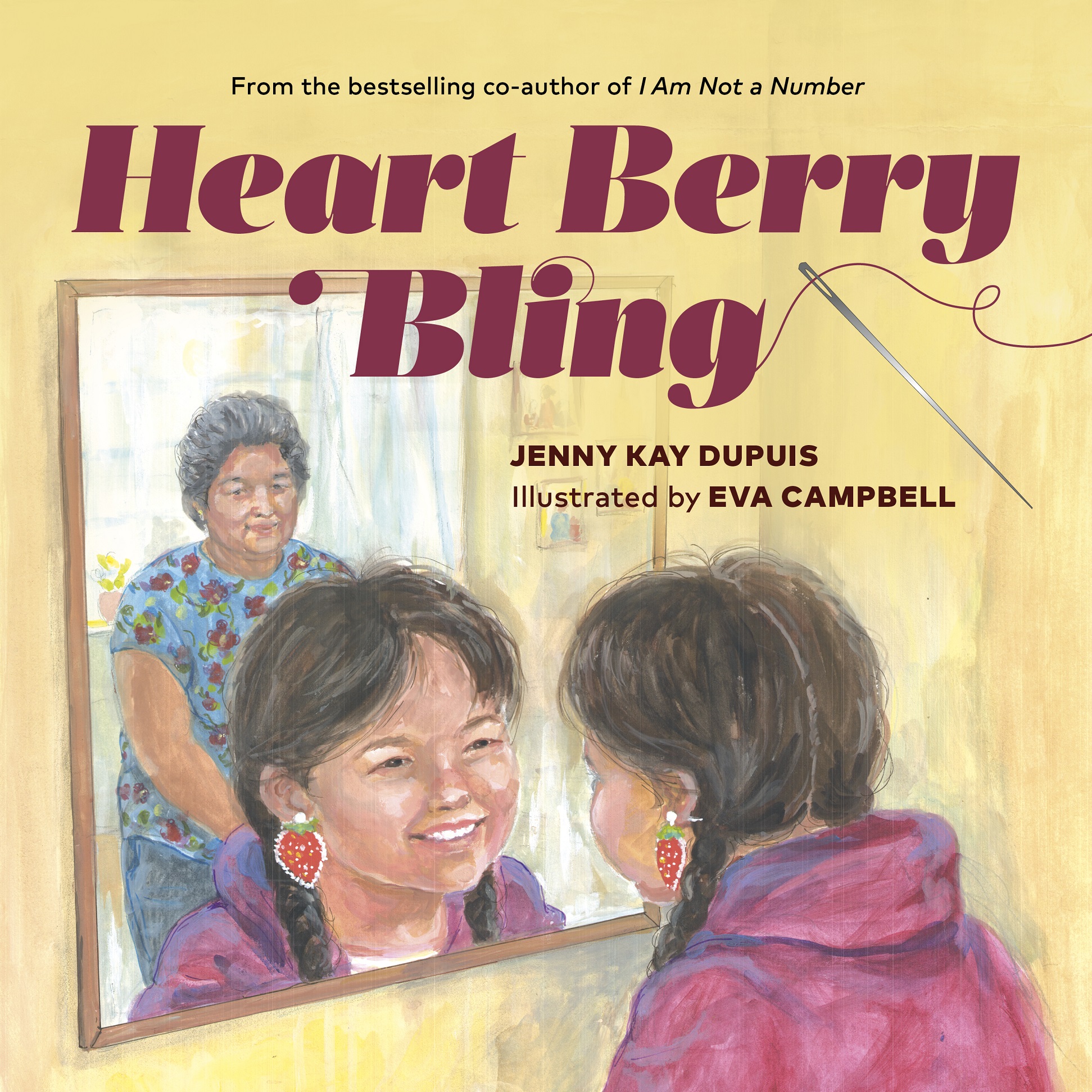
“I made the decision to begin by creating a conversation between two relatable characters—a grandmother who is Anishinaabe and lives in the city, and her granddaughter, Maggie,” Dupuis explains. The story opens when Maggie visits her grandmother, and is excited to begin her first-ever beading project: a pair of strawberry earrings. However, beading turns out to be much harder than she expected. But as they work side by side, Granny shares how beading has helped her to stay strong and connected to her Anishinaabe culture—especially after she lost her First Nations status and was forced to leave her home community.
Maggie learns how Granny, like many other First Nations women, lost her status because she married someone without status—an unfair law that did not apply to men. As Maggie learns about patience and perseverance from her granny’s teachings, she also discovers that beading is a journey – and that, like every journey, it’s easier to travel with a loved one. “I used clear, basic language that young readers could comprehend, and broke the complex ideas about the Indian Act up into manageable chunks,” Dupuis elaborates. “I also decided to illustrate how First Nations women have worked to try to overcome the legacy of the Indian Act, and how it affected just one family out of thousands, in order to illustrate the history of the Indian Act in the present. This makes it easier for the reader to relate to the event.”
The illustrations by Eva Campbell play a crucial role in preserving and sharing the culture and traditions shared by Maggie and her family in the story, such as eating meals, browsing through Granny’s beaded creations for ideas, and beading at the kitchen table. These images bring to life the relationships of a young Anishinaabe girl, her father and her urban grandmother – creating a compelling contemporary depiction of the importance of family in Anishinaabe culture.

The result is a beautifully illustrated tale in which children learn about the tradition of Anishinaabe beadwork, “strawberry teachings” and gender discrimination in the Indian Act. Yes, Heart Berry Bling is a story about discrimination and racism, but it is also a universally relatable story about the relationship between a grandmother and granddaughter and the resilience found in shared heritage. And Dupuis hopes that young readers “will recognize the value of connections and the lessons about taking care of oneself and others that have been shared”. She also notes that “the addition of the strawberry, or heart berry teachings, was crucial to the story, particularly when it comes to Granny’s efforts to move past her painful history and discover coping strategies, so she might discover (or experience) Indigenous joy.”
Dupuis has been recognized as a trailblazer in Indigenous education, and has received numerous awards for her contributions. With Heart Berry Bling, “the biggest challenge was attempting to go beyond what is considered the ideal length for a picture book. . . . Its length was increased by the way I shaped and explained the narratives using cultural contexts and detailed descriptions. As an Indigenous author and educator, I felt it was important to draw on historical, contemporary, and cultural contexts from my own lived experiences to create a narrative that would resonate with readers.
As one example, specific elements of Heart Berry Bling were inspired by Dupuis’ vivid memories of visiting her own grandmother’s apartment in the city: “My father and I would climb the steep staircase to her apartment. When you arrived, she was frequently on the kitchen phone, talking to her sister or another family member. We frequently sat on a couch she proudly purchased with her BINGO winnings in her living room, wrapped in a crochet blanket she had crocheted”.
This kind of depth and personal relevance make Heart Berry Bling not just a story, but “also a teaching tool for readers to learn and acquire knowledge about significant events and knowledge”. And as a teacher herself, Dupuis provides recommendations for how teachers might use Heart Berry Bling to incorporate Indigenous education: “Numerous instructional strategies listed in the teacher’s resource guide (prepared by Jerica Fraser, a friend/former education colleague) can be used by educators who are reading Heart Berry Bling to their students. As teachers and students read together, they can use some of the questions to spark dialogues that can improve comprehension and help students explore connections:”
- Which places or spaces do you get excited about visiting? What makes them special to you?
- How do you think Granny felt when she had to move away from her community?
- How do both Maggie and Granny show perseverance and resilience throughout the Heart Berry Bling?
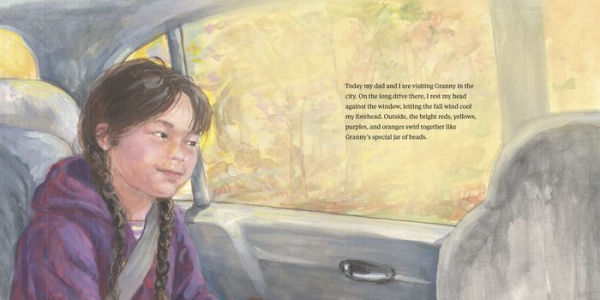
With its vibrant illustrations and rich personal and cultural context, Heart Berry Bling is a meaningful, memorable journey through the experiences of Maggie, her family, and the Anishinaabe people. And ultimately, Dupuis has twin hopes for her picture book: to provide Indigenous readers “with an important story that reflects their own traditions and values”, and to introduce non-Indigenous readers to both “some unjust realities that many First Nations and children face” and “the beauty and joy of Anishinaabe culture.”
© Arpita Ghosal, SesayArts Magazine, 2023
About The Author
Arpita Ghosal
Arpita Ghosal is a Toronto-based arts writer. She founded Sesaya in 2004 and SesayArts Magazine in 2012.
Visit About Us > Meet the Team to read Arpita’s full bio …

